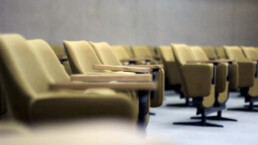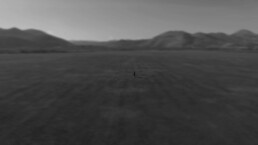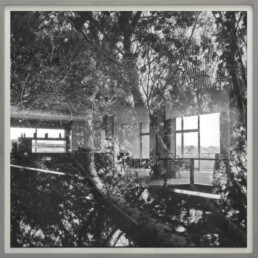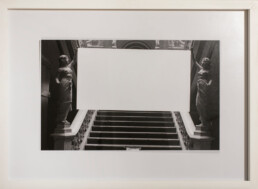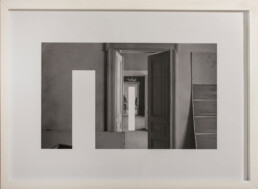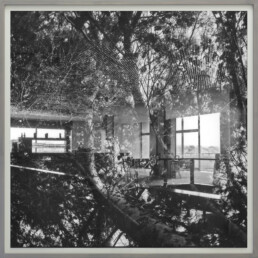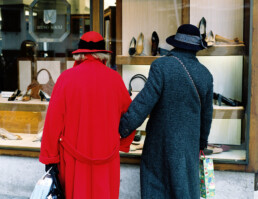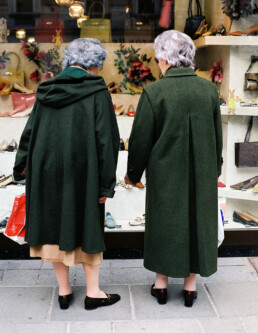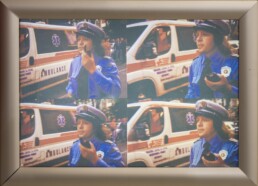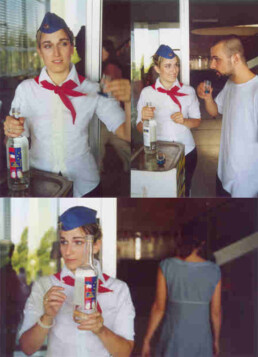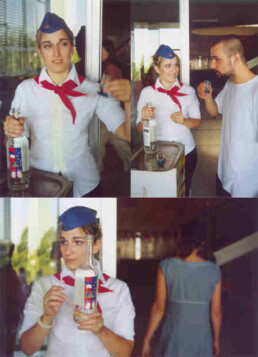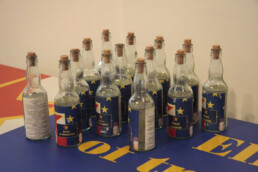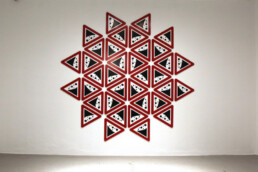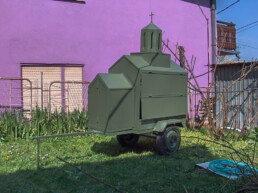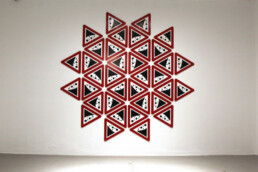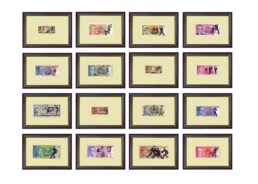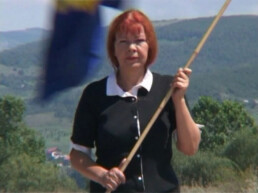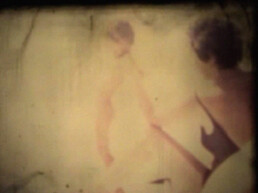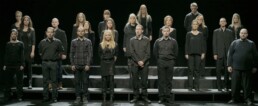Igor Bošnjak
IGOR BOŠNjAK (1981)
Hotel Balkan
video
10’27”
edition: 1/8
2013
Is There Death After Life?
video
7’30”
2018
Hotel Balkan
video
10’27”
edition: 1/8
2013
The work Hotel Balkan is a meditative and ambient video that defines the boundary between futuristic memories of the past and present imagining of the future. There are images from the past which can be immediately recognized as being from the past, but we still perceive them as if they were futuristic. The film was shot in Tito’s bunker in Konjic (Bosnia and Herzegovina).
It was screened at the 55th October Salon.
© Cultural Centre of Belgrade, the October Salon Collection and the artist
Gift Contract: III-5-105/6.3.2015.
Inventory No. 076
Photo: still from the video work
Is There Death After Life?
video
7’30”
2018
The main artistic value of the video work Is There Death After Life? lies in naming and language. The basic philosophical, i.e., ontological issues on which the weight of this work rests are achieved simply by inversion of the words ‘death’ and ‘life’ in the dogmatic question “is there life after death?”, which, for a moment, creates confusion as the basis for the possibility for new questions and conclusions. With the aesthetics of dystopia and landscape cinema in the relationship between the figure and the landscape, the artist emphasizes the idea of isolation, anticipation, impossibility of final knowledge/cognition and captivity within the perception of time limited by man, and attempts at its extension.
For this work, the artist received the Zvono Award in 2018.
© Cultural Centre of Belgrade, the October Salon Collection and the artist
Purchase Contract: III-5-380/31.10.2019.
Inventory No. 1662
Photo: still from the video work
ABOUT THE AUTHOR:
Igor Bošnjak (1981, Sarajevo, Bosnia and Herzegovina) lives and works in Trebinje, Bosnia and Herzegovina. His practice is mostly in film, video, installation and photography. Currently, he works as an assistant professor at the Academy of Fine Arts in Trebinje. He graduated and received a master’s degree in painting from the Academy of Fine Arts in Trebinje in 2005, and completed interdisciplinary master studies at the University of Arts in Belgrade. He has participated in numerous exhibitions and festivals around the world and won a number of awards, including those for the Best Young Artist in B&H in 2018, at the 49th Salon in Herceg-Novi, for experimental video at the 4th Salon in Velenje… More information at www.igorbosnjak.com
Mladen Bizumić
MLADEN BIZUMIĆ (1976)
In Transition #3
black and white photograph on baryta paper
20 cm x 34 cm
2012
In Transition #7
black-and-white photograph on baryta paper
20 cm x 34 cm
2012
Hotel Yugoslavia (Double Exposure)
black and white photograph on baryta paper
100 cm x 100 cm
2010
In Transition #3
black and white photograph on baryta paper
20 cm x 34 cm
2012
In Transition #7
black-and-white photograph on baryta paper
20 cm x 34 cm
2012
The In Transition series was made as a site-specific work within the 53rd October Salon (Good Life, 2012). The interior shown in the photographs is the space of the Geozavod building, where the exhibition was held. The artist makes arrangements that look like scenes in anticipation of an event that is yet to happen. He sets precise and playful empty spaces, changes in which there is a constant tension between expectation/anticipation of events, contents and contexts.
The Geozavod building was the central venue of the 53rd October Salon and an inducement for the participating artists to create a work for the occasion. Through the complexity of the history and development of the building, all socio-political relations of particular periods were apparent. The photographs taken in it and the way they were presented (in the found cabinets – the abandoned inventory of previous occupants of the building space) open new points of perception in exploring people’s relationship towards their surroundings.
© Cultural Centre of Belgrade, October Salon Collection and the artist
Gift Contract: III-5-289/1/24.9.2014.
Inventory No. 1350
Photo: Courtesy of the artist, Milan Kralj
Selected Bibliography:
53rd October Salon, Good Life: Physical Narratives and Spatial Imaginations. Cultural Centre of Belgrade, 2012
Hotel Yugoslavia (Double Exposure)
black and white photograph on baryta paper
100 cm x 100 cm
2010
The photograph Hotel Yugoslavia (Double Exposure) was part of the site-specific project created during the artist’s exploration of the hotel building and its relationship to the immediate environment. The photograph Double Exposure (as well as other photographic and video works in this series) with the evident distortion of the “picture”, accomplished by re-illuminating the analogue film, points to the fragility of space and its dependence on the relation of consciousness and feeling.
As one of the first planned representative buildings in the new modern city that was emerging on the territory of today’s Novi Beograd after 1948, Hotel Yugoslavia served as a starting point when it comes to the artist’s interest in the modernist heritage in the former Yugoslavia. Namely, from the first crisis the hotel experienced in the 1980s, through the extensive damage during the NATO bombing of Belgrade in the 1990s, to the privatization in the 2000s, this representative building was left to gradually decline. Bizumić starts from his own perception of the current condition of the hotel by analysing the potential of this building, as well as the potential of the entire modernist heritage. Hotel Yugoslavia is presented as a ruin, but also as a space for a possible reaffirmation of social consciousness.
© Cultural Centre of Belgrade, October Salon Collection and the artist
Purchase Contract: III-5-516/24.12.2014.
Inventory No. 1389
Photo: Courtesy of the artist
Selected Bibliography:
Mladen Bizumić Hotel Yugoslavia, Mar. 29 – May 6, 2012, catalogue for the exhibition at the Salon of the Museum of Contemporary Art, Belgrade, 2012
Daniel Horn, “Mladen Bizumić: Salon of the Museum of Contemporary Art Belgrade”, FRIEZE, No. 149, September 2012, 174
ABOUT THE AUTHOR:
Mladen Bizumić (1976, Sremska Mitrovica, Serbia) graduated from the Auckland Academy of Fine Arts and completed his doctoral studies at the Faculty of Fine Arts in Vienna. He works in various media; his descriptions (presentations) often look like scenes in anticipation of an event that is yet to occur, causing tension between the works and their presentation, content and context. He has exhibited at numerous major international exhibitions such as the 9th Lyon Biennale, 10th Istanbul Biennale, 3rd Vienna Biennale, 2nd Moscow Biennale, 1st Auckland Triennial, etc. He lives and works in Vienna (Austria) and Auckland (New Zealand). More information at www.mladenbizumic.net
Aleksandrija Ajduković
ALEKSANDRIJA AJDUKOVIĆ (1975)
Similar
photograph lined on aluminium plate
50 cm x 70 cm (3 pcs)
2006
Crime Scene
3 framed lomographs and 1 photograph
20 cm x 30 cm x 10 cm; 100 cm x 70 cm
2012
Similar
photograph lined on aluminium plate
50 cm x 70 cm (3 pcs)
2006
The series of photographs was taken in Vienna and Barcelona in 2006 and 2007. By portraying random passers-by, non-professional models in an elaborate and humorous way, she records phenomena related to contemporary life and its everyday reflections in the domains of fashion, pop culture and the lifestyle of (non)urban environments.
In a certain sense, Aleksandrija Ajduković’s practice has been a phenomenon on the Serbian photographic scene for several years due to her interest in hybrid models of presence and culture of spectacle. The Similar Series points to some cycles created at about the same time (Tigresses, Chinese, Fashion Journal…), and to the author’s continuity in her work as a visual anthropologist. The work of Aleksandrija Ajduković often demonstrates her interests within phenomena in reality; she examines specific cultural models – the lifestyle of individuals and groups, fashion (self-fashioning), taste, but also the potential of photography as a resource for its further dispersion into other media formats.
© Cultural Centre of Belgrade, October Salon Collection and the artist
Gift Contract: III-5-289/24.9.2014.
Inventory No. 1351
Photo: Milan Kralj
Selected Bibliography:
Aleksandrija Ajduković: NONAME Riviera, Sept. 16 – Oct. 23, 2016, catalogue of the solo exhibition, Salon of the Museum of Contemporary Art, Belgrade, 2016
Aleksandrija Ajduković, Tretman tela u popularnoj vizuelnoj kulturi: teorija animal printa, doctoral dissertation, University of Belgrade, Faculty of Dramatic Arts, Theatre, Film, Radio and Television, Belgrade, 2018
Crime Scene
3 framed lomographs and 1 photograph
20 cm x 30 cm x 10 cm; 100 cm x 70 cm
2012
The works from the Crime Scene Series throw light on the places of suffering or crime that the author photographed in the period from 2008 to 2012. It is a work on the photographers’ scavenger nature, on crime scene reports, death and the circumstances of dying and the possibilities of positioning such photographs on the international art photography market.
Aleksandrija Ajduković started this series while working in Italy and continued it when she returned to Serbia, where she kept going to the field with journalist teams. This series of photographs can also be seen as the documentation of her performative work within the research of the anthropological aspect of the spectacle of death and misfortune in modern society. For Aleksandrija Ajduković, crime scenes are perverted and inspiring for experimental photographic work she does in the field – following the crime scene reports, but she records them from a somewhat different perspective.
© Cultural Centre of Belgrade, October Salon Collection and the artist
Purchase Contract: III-5-475/15.12.2014.
Inventory No. 1379
Photo: Courtesy of the artist, Milan Kralj
Selected Bibliography:
Aleksandrija Ajduković, “Smrt – od tabua do popularne culture”, in Kultura: journal for the theory and sociology of culture and cultural policy, No. 146, Belgrade, 2015, pp. 264–274
ABOUT THE AUTHOR:
Aleksandrija Ajduković (1975, Osijek, Croatia) graduated in photography from the BK Academy of Arts in Belgrade and completed her master’s studies at the Academy of Arts in Novi Sad. She was Marina Gržinić’s guest student in Post Conceptual Art Practices at the Academy of Fine Arts in Vienna. By portraying random passers-by, non-professional models in an elaborate and humorous way, she records phenomena related to contemporary life and its everyday reflections in the domains of fashion, pop culture and the lifestyle of (non)urban environments. Photographs are the starting point for a media archaeology of private video archives of the people who either live or work in the facilities represented in the photographs, or are part of home video production. She was a finalist for the Dimitrije Bašičević Mangelos Award twice, won Henkel Youth Artists Prize in 2005 and the 45th October Salon Award. She has had a large number of solo and group exhibitions in the country and abroad. More information at http://ajdukovicaleksandrija.com/
Mrđan Bajić
MRĐAN BAJIĆ (1957)
Angel
charcoal and Indian ink wash on handmade paper
170 cm x 125 cm
2012
Angel
charcoal and Indian ink wash on handmade paper
170 cm x 125 cm
2012
The drawing Angel is a variation of sketches for his hybrids, as Bajić’s sculptures are often described. Drawings – models, designs and sketches, lost, started and forgotten works make a large part of the artist’s oeuvre and they are the basis for realizing sculptures. The work belongs to the series Projects, which was being created between 2010 and 2012. This series is characterized by agitated, though clear and thoughtful drawing strokes, combined with various materials, which the author applies on paper.
The term sculptotecture (derived from the words sculpture and architecture), as “two in one”, is one of the important characteristics of Mrđan Bajić’s work. Since 2006, the artist has been making maquettes of Angels, i.e., small and large sculptures that serve as sketches for large sculptotectures. These maquettes-assemblages also function as testing models for experiments on relationships among materials, traditional approaches, and incompatible elements and motifs.
© Cultural Centre of Belgrade, October Salon Collection and the artist
Gift Contract: III-15-132/25.7.2012.
Inventory No. 002
Photo: Courtesy of the artist
Selected Bibliography:
Ana Bogdanović, Mrđan Bajić: Sculptotecture, Belgrade: Vujičić Collection Foundation, 2013
Leonida Kovač, Mrđan Bajić: rasprizorujuće transverzale, Belgrade: Supervizuelna, 2017
Nevena Martinović, Mrđan Bajić, 6 – 24.06. 2015, Kragujevac: Rima Gallery, 2015
Marija Stanković, Mrđan Bajić, Nov. 14. – Dec. 20, 2019, Kragujevac: Rima Gallery, 2019
ABOUT THE AUTHOR:
Mrđan Bajić (1957, Belgrade, Serbia) is one of the most prominent Serbian sculptors. From the very beginning, his art practice has been based on experimenting with materials, form and the method of constructing sculptures. In his artworks, he takes an engaging, critical approach to the experiences from the immediate past and the turbulent present. A special and complex years-lasting project in the artist’s oeuvre is Yugomuzej, also presented at the 2002 Sao Paulo Biennial. He represented Serbia at the Venice Biennale in 2006. At the 48th October Salon in 2007, the installation of drawings titled 11 Stupid Projects was exhibited. He is a professor at the Sculpture Department of the Faculty of Fine Arts in Belgrade. Based in Belgrade. More information at www.mrdjanbajic.net
Antea Arizanović
ANTEA ARIZANOVIĆ (1978)
Elixir of transition, 2004, installation, 120 x 130 x 50 cm
Elixir of Transition
installation
variable dimensions (120 cm x 130 cm x 50 cm)
2004
Elixir of Transition was a performative action at the opening of the 45th October Salon, when the author, dressed in a pioneer uniform, served a magic potion to treat the symptoms of transition in the new political system. She was selling the drink at a price of one euro, and it went with a simple recommendation and warning – The drink helps if you drink it in drops but it is very dangerous to drink a whole bottle. Elixir of Transition is a medicine-drink that can bring pleasure or pain, depending on the speed of drinking.
In her earlier work, Antea Arizanović was interested in finding and redefining her identity in the context of ethnicity. In most of her projects, she has dealt with the image of woman in the mass media and how the external view on a woman who does not find a balance between manipulative consumer ideals, her own desire to please and the awareness of the possibility of seeking her integrity without patriarchal shackles. She often uses well-known images from the history of art, religion or pop culture, which are part of the cultural memory of each individual.
© Cultural Centre of Belgrade, October Salon Collection and the artist
Gift Contract: III-5-296/29.9.2014.
Inventory No. 1361
Photo: Cultural Centre of Belgrade, installation view 45th October Salon
Selected Bibliography:
45th October Salon, Continental Breakfast. Cultural Centre of Belgrade, 2004
ABOUT THE AUTHOR:
Antea Arizanović-Mutaović (1978, Slovenia, Ljubljana) graduated from the School of Drawing and Painting in Ljubljana, and received her master’s degree in painting from the Faculty of Fine Arts in Belgrade. Since 2001 she has presented her works at solo and group exhibitions in the country and abroad. Her main focus is on the issue of identity and she explores its transformations in various areas. Together with costume designer Jovana Božović, she created the brand Remake Home. She does design and remodelling of antiques. Lives and works in Belgrade.
Radoš Antonijević
RADOŠ ANTONIJEVIĆ (1969)
Long Journey to Europe
sculpture
220 cm x 288 cm x 101 cm
2009–2012
Perfection
wall installation of 36 road signs
280 cm x 280 cm x 10 cm
2015
Long Journey to Europe
sculpture
220 cm x 288 cm x 101 cm
2009–2012
The work Long Journey to Europe is part of a series of sculptures, hybrid objects, which Antonijević initiated in 2006, where he uses elements of church buildings and elements of tents. The hybrid object created by combining different forms becomes an object with the character of an industrial product and the sculpture gets a new “function”. In a way, he creates the objects that are a product and mirror of social reality that has changed through the wars, in which different identities (Balkan, post-Yugoslav, national, Eastern European, religious) are intertwined.
Antonijević uses colour as much as form (volume and plasticity), to define artworks, introducing an additional level of meaning. The olive-green colour clearly evokes a military character, while the motif of the trailer in combination with the grill resembles a portable “barbecue”.
As the artist himself points out, the title of the work makes you think of the mobility of the object, and this military-church trailer without its own drive was made to shed light on Serbia’s controversial position in relation to Western Europe during the transition period. Antonijević thus suggests and draws attention to the fact that the entire society in the mentioned period has turned into an inert mass that only has hedonistic-masochistic potential.
© Cultural Centre of Belgrade, the October Salon Collection and the artist
Gift Contract: III-5-220/1/14.8.2014.
Inventory No. 1334
Photo: Courtesy the artist
Selected Bibliography:
Radoš Antonijević, KOREKTIVI OBLIKA: Vodič kroz skulptorske fenomene, Belgrade: ProArtOrg, 2014
Radoš Antonijević, Na svome mjestu stajati, catalogue of the solo exhibition, Museum of Contemporary Art of Republika Srpska, Banja Luka, 2017
Radoš Antonijević, Dekoltei i brojanice, Aug.a 23 – Sept.13, 2019, catalogue of the solo exhibition, Museum of Contemporary Art of Vojvodina, Novi Sad, 2019
Sonja Jankov, “Arhitektonske makete u suvremenim umjetničkim praksama postsocijalističke”, Život umjetnosti, a journal for modern and contemporary art of Republika Srpska, Banja Luka, 2017
Sonja Jankov, “Arhitektura u diskursu savremene umetnosti”, text in the catalogue of the exhibition XIV UAD (Art, Architecture, Design) – To Build Again: Artists on Architecture, Nov. 11 – Dec. 6, 2019, Cultural Centre of Pančevo: Gallery of Contemporary Art, Pančevo, 2019, 4–11
Perfection
wall installation of 36 road signs
280 cm x 280 cm x 10 cm
2015
Perfection consists of 36 road signs warning of falling rocks on the road, specially made for the needs of the work. For the artist, they represent a schematic image of a material that rolls, shreds and changes shape. Precisely arranging the triangular signs, the artist forms a new image within the composition in which the rectilinear movement of rolling rocks becomes circular, and the landslide on the road interpreted as a warning is seen in the broader picture of reality as a segment of a harmonious process.
As Antonijević himself claims – every landslide is part of a circle, a story about the circulation of matter and the harmony of movement.
© Cultural Centre of Belgrade, the October Salon Collection and the artist
Purchase Contract: III-5-311/12.12.2017.
Inventory No. 1500
Photo: Courtesy the artist
Selected Bibliography:
Radoš Antonijević, Neka vrsta radosti, Apr. 8 – May 11, 2015, catalogue of the solo exhibition, Salon of the Museum of Contemporary Art, Belgrade, 2015
Aleksandra Ćuk, “Svet je sočan, ali ume da zasmrdi” (interview with the artist), Danas, Belgrade, Apr. 29, 2015, https://www.danas.rs/kultura/svet-je-socan-ali-ume-da-zasmrdi/, accessed on Mar. 20, 2020
Žolt Kovač, “Radoš Antonijević / Neka vrsta radosti” (interview with the artist), Supervizuelna – magazine for contemporary art, Belgrade, May 12, 2015, http://www.supervizuelna.com/rados-antonijevic-neka-vrsta-radosti/, accessed on Mar. 20, 2020
Guided tour of the exhibition Some Kind of Joy, SEEcult.org, 2015, https://www.youtube.com/watch?v=j3-tWdeD0Fk, accessed on March 20, 2020
ABOUT THE AUTHOR:
Radoš Antonijević (1969, Pančevo, Serbia) graduated and obtained a master’s degree and doctorate in sculpture from the Faculty of Fine Arts in Belgrade. He rethinks the medium of sculpture and its boundaries, creating works that problematize the relationship among form, function, materiality and perception. The subjects of his sculptural works are often history, politics, culture and society. His most representative solo exhibitions have been at MSURS (Museum of Modern Art of Republika Srpska) in Banja Luka (2017) and Salon of the Museum of Contemporary Art in Belgrade (2015), while the most important group exhibitions he has participated in include those at the National Museum of Contemporary Art in Bucharest (2014), Museum of Contemporary Art in Belgrade (2012), Styrian Autumn Festival in Graz (2009) and the October Salons in Belgrade (2003, 2004, 2006). He is a professor at the Faculties of Fine Arts in Belgrade and Banja Luka. Lives and works in Belgrade and Smederevo. More information at https://radosantonijevic.weebly.com
Jelica Rаdоvаnоvić and Dејаn Аnđеlkоvić
JELICA RADOVANOVIĆ (1957)
DEJAN ANĐELKOVIĆ (1958)
Long Live Work
installation – gouache on 16 old banknotes
2012
Long Live Work
installation – gouache on 16 old banknotes
2012
It is 16 interventions on banknotes whose value expired in different periods and occasions in the past of Serbia. The artists illustrate the rapid changes and disturbances of the value system by intervening with the gouache technique on the then valid banknotes, which became worthless due to hyperinflation.
The value discrepancy is obvious in the relationship between the work to be paid and the figure on the banknotes – it cannot cover the value of the work.
Long Live Work subtly illustrates the period of the nineties, characterized by turbulent, radical social changes, as well as by examining the place and role of art in the community and given circumstances.
© Cultural Centre of Belgrade, the October Salon Collection and the artists
Purchase Contract: III-5-375/16.11.2016.
Inventory No. 1452
Photo: Milan Kralj
Selected Bibliography:
Multimedijalni projekat Jelice Radovanović i Dejana Anđelkovića, Apr. 3–20, 2012, Gallery of Contemporary Art of the Cultural Centre of Pančevo, exhibition catalogue, Pančevo, 2012
Jasmina Čubrilo, Jelica Radovanović and Dejan Anđelković: symptom. DJ, Beograd: Vujičić Collection Foundation, 2011
ABOUT THE AUTHORS:
Jelica Radovanović (1957, Dubrovnik, Croatia) and Dejan Anđelković (1958, Kraljevo, Serbia) have worked together as an art couple since 1991. They both graduated in painting from the Faculty of Fine Arts in Belgrade. They respond thoughtfully and convincingly to the social system and the position of the artist in it. In their approach to the engaged, politicized art, they are not satisfied by noticing current problems, but ask questions, problematize and interrelate them. Theoretically, their works rely on relational aesthetics – they reconstruct a complex set of questions that follow a certain epoch, and consider different answers to them. Consciously choosing the margin as the position from which they act, they exhibit only when they have something to say.
Gordana Anđelić Galić
GORDANA ANĐELIĆ-GALIĆ (1949)
Mantra
video
5’30”
edition: 1/5
2006
Mantra
video
5’30”
edition: 1/5
2006
The video performance in which the artist carries different flags while walking on a deserted road, somewhere on the outskirts of Sarajevo, talks about a constant return to the past, often used by politicians as a means of manipulating the population. The work is really about the burden of the past that every political option that comes to power leaves us with, and therefore this story has no beginning and no end.
Mantra was premiered in Belgrade at the exhibition Collection 3. Searching for…, curated by Aleksandra Estela Bjelica Mladenović, at the Art Gallery.
The work was awarded at the first SPAPORT biennial in Banja Luka in 2008.
Initially, the artist is carrying the flag of Bosnia and Herzegovina. But as she is walking the empty road, somebody (we don’t see who) is throwing all the other flags that used to represent Bosnia and Herzegovina through history, twenty-four of them. At the moment when she is to take the current flag, the one used after the breakup of the former Yugoslavia, all the others are starting to fall out of her hands due to the burden she is carrying.
The title of the work also refers to the process during which, after a relentless repetition, an individual enters a state of nirvana, only that nirvana, in the process a people go through due to the repetition of history, is equal to complete numbness and apathy.
© Cultural Centre of Belgrade, October Salon Collection and the artist
Gift Contract: III-5-219/1/14.8.2014.
Inventory No. 1338
Photo: still from the video work
ABOUT THE AUTHOR:
Gordana Anđelić-Galić (1949, Mostar, Bosnia and Herzegovina). She graduated from the Faculty of Philosophy in Sarajevo, History Department, in 1975 and, in 1988, from the Sarajevo Academy of Fine Arts. She has had a large number of solo and group exhibitions and received numerous awards; participated in the Venice Biennale twice, but at the invitation of other countries – Italy and South Korea. In 2012 she was appointed Director of the Collegium Artisticum Gallery in Sarajevo. Lives and works in Sarajevo.
Ana Adamović
ANA ADAMOVIĆ (1974)
Madeleines
one-channel video, colour, sound
3’42”
edition: 1/5
2004
My Country Is the Most Beautiful of All
three-channel video installation
2’51”
2011–2013
Madeleines
one-channel video, colour, sound
3’42”
edition: 1/5
2004
“With the series Madeleines, the artist started exploring into the nature of human memory. Old family photographs, recorded by an eight-millimetre camera, form the basis of the work. The video works were created through photo manipulations – they act as a window into the subconscious, with their aesthetics and the atmosphere they induce. The boundary between a true event from the past and a memory created through the image is being deleted.
Milica Pekić, from the catalogue of the 51st October Salon
Ana Adamović participated in the 47th October Salon Art, Life and Confusion, with Postcards from Imaginary Places, and in the 49th October Salon with the work Revealing. Her video Canzona was awarded at the 51st October Salon, at which the work Madeleines was also exhibited. At the 55th October Salon, she presented the three-channel video installation The Choir.
The mechanism of memory has not yet been fully explained. Numerous and complex clues lead us to our personal memories. The works from the Madeleine Series, begun in 2004, aim to explore images that are or might be memory triggers. With photographs and video works, the author opens up possibilities for different interpretations of individual and collective images of the past.
“The title of the series – Madeleines – comes from Proust’s novel In Search of Lost Time. Madeleine is a small cake that, dipped in tea, becomes a trigger for the writer’s memory. Thanks to madeleine, the author started his search of lost time.”
Ana Adamović
© Cultural Centre of Belgrade, October Salon Collection and the artist
Gift Contract: III-5-220/14.8.2014.
Inventory No. 1332
Photo: still from the video work
My Country Is the Most Beautiful of All
three-channel video installation
2’51”
2011–2013
Kolibri was the most famous children’s choir in the former Yugoslavia. It was founded by Milica Manojlović, in 1963, as the children’s choir of the Radio-Television Belgrade. (Interestingly, in the same year Yugoslavia changed its name from the Federal People’s Republic of Yugoslavia to the Socialist Federal Republic of Yugoslavia, the name it would hold until its break-up). During the 1970s and 1980s, Kolibri sang both children’s and patriotic songs, most often written especially for them. From the mid-1970s, the song My Country Is the Most Beautiful of All became part of their standard repertoire and the choir sang it on various occasions for almost three decades.
“In April 1987, the choir had a concert at the Belgrade Kolarac Concert Hall. The former choir members who were present in the audience joined the choir on the stage to sing the last two songs together. One of these songs was My Country Is the Most Beautiful of All.
Four years after the concert, a war in the Former Yugoslavia broke out. The violent disintegration of the country finally ended with the NATO intervention in the then FRY in 1999. During this war, the largest conflict in Europe since World War II, more than 130,000 people were killed.
Exactly 24 years after the concert at Kolarac and 20 years after the war began in the Former Yugoslavia, some of the former members of the Kolibri Choir reunited in the same city but in a completely different country – to sing the song My Country Is the Most Beautiful of All once again.”
Ana Adamović
My Country Is the Most Beautiful of All– Svetislav Vuković
When springtime paints the landscape / in crimson, green and gold, / when leaves of crops are swaying and on the whole, / my country is the most beautiful of all. //I love it when its skies/ with colours of a rainbow glow, / I love it when it is hidden / under a blanket of snow. / On the whole, / my country is the most beautiful of all. // The land of glory and heroes / I keep it in my soul, /I’m proud of it always. / My country is the most beautiful of all.
© Cultural Centre of Belgrade, October Salon Collection and the artist
Purchase Contract: III-5-155/25.5.2016.
Inventory No. 1427
Photo: still from the video installation
Selected Bibliography:
47th October Salon, Art, Life and Confusion. Cultural Centre of Belgrade, 2006
49th October Salon, Artist – Citizen. Cultural Centre of Belgrade, 2008
51st October Salon, The Night Pleases Us. Cultural Centre of Belgrade, 2010
55th October Salon, Disappearing Things. Cultural Centre of Belgrade, 2014
Two Choirs, Ana Adamović, Feb. 28 – Mar. 23, 2014, Salon of the Museum of Contemporary Art, Belgrade, 2017
ABOUT THE AUTHOR:
Ana Adamović (1974, Belgrade, Serbia) deals with issues of identity and memory, both personal and collective, working on the long-term photo and video projects. Since 1999 she has exhibited in the country and abroad. She graduated in world literature from the Faculty of Philology in Belgrade, studied photography at the Boston Art Institute and obtained a PhD from the Academy of Fine Arts in Vienna. She is the founder of Kiosk, a platform for contemporary art. Lives and works in Belgrade. More information at http://anaadamovic.com/
